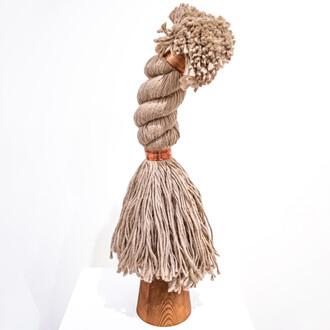The Reading Box, The Moon, Misfortunes and Crimes' is Brazilian artist Rivane Neuenschwander's fifth exhibition at Stephen Friedman Gallery. The exhibition includes the artist's first four-channel projection, a new site-specific installation, collages and a group of her iconographic 'Ex-voto' paintings.
Neuenschwander's unique practice draws on the history of Latin American conceptualism to investigate phenomena that lie just outside our collective field of vision. Each work begins with a particular cultural idea – a game, a religious offering or a childhood memory – that is then dissected and reborn in Neuenschwander's unique style. The works in this exhibition examine the role of memory in culture, particularly how trauma and memories of conflict are connected to the present. In doing so the artist addresses the current state of the world, and makes suggestions about the form that fear and conflict might take in the future. With fervent and analytical curiosity, the artist continues her uniquely humanist project in which local scenarios and global ideas come together in powerfully engaging works.
Visually striking and viewed through the window of the gallery is an important new installation called ‘History and Infancy (WAR)’. Brightly coloured flags strung on nautical rope and anchored by glacial boulders criss-cross the room. The work takes its title from the strategic board game ‘War’, known in the United Kingdom as ‘Risk’. Each flag in the installation bears reference to a territory in ‘War’, and a flag from the International Code of Maritime Navigation. The outline of each territory is stitched over the geometric shapes of the maritime flags, with its name printed as it appeared in the 1970s Brazilian edition of the game. In total there are forty-three flags that correspond to forty-two territories in the original game, plus one extra that Neuenschwander has included to represent the ‘Guarani Aquifer’. This is a huge underground reserve of potable water so significant that it is considered a possible trigger for future conflict. Neuenschwander questions the nature of war now, using the Cold War, Brazilian military dictatorship of the 1970s and more recent conflicts as a starting point.
On entering the dark space of ‘Cabra-Cega’, viewers are met with monsters baring their teeth; strange bodies with outstretched wings leap out of the darkness. Scenes of war and destruction flash on and off. Armies of stick men armed with canons move across the wall, trees are set alight and rockets shoot into the darkness. Intermittently, flecks of white light or small round shapes fill the wall – like stars in the sky. The imaginary nightmares of childhood appear from all the corners of the room. ‘Cabra-Cega’ is Neuenschwander’s first four-channel projection and draws its title and inspiration from a children’s game known in the United Kingdom as ‘Blind man’s bluff’. Neuenschwander began this work from drawings of strange creatures and monsters made by a child aged between five and seven years old. She then made her own illustrations from these, and the projection set to a specially commissioned soundtrack by Brazilian musician Arto Lindsay. Adjacent to the projection room is a series of new collages that further examine childhood fears. These are derived from children’s cut-outs made during a workshop at the Museu de Arte do Rio, as part of the artist’s recent solo presentation at the museum. Neuenschwander translated the images of scary beings into screen-prints, over which she has collaged coloured gel sheets.
The exhibition also includes a group of new paintings inspired by traditional Latin American Ex-voto paintings. These are small devotions that are placed in a church or chapel as an offering to a saint or divinity, to request a grace. They are usually short stories that recount everyday tragedies. In her paintings, Neuenschwander removes all the text and figures from the original Ex voto, leaving only the geometric architectural shapes of the scene. Without the drama of the story, the architecture becomes a geometric abstraction in its own right. Each painting includes a looming otherworldly egg and a splash of blood. The former takes the place of the saint in the original Ex-voto: Neuenschwander replaces the divine being with a symbol of life, rebirth and fertility. The splatter of vibrant red blood remains from the original painting, and the viewer is left to fill in the scene: was it a crime, domestic violence, an assault?
This exhibition incorporates all of the strands of Neuenschwander’s practice - moving image, painting, installation and works on paper. Her critical research is as meticulous as her production: each technique is attuned to its subject matter and is precise in its execution. Together the works investigate Neuenschwander’s interest in the “functioning of memory and its distortions, the influence of fantasies on recollection and the amnesia of childhood”.
















